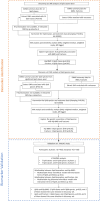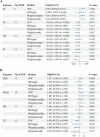Identification and Validation of Novel Lipids Linked to Bone Mineral Density Change and Fracture Risk
- PMID: 40560432
- PMCID: PMC12198305
- DOI: 10.1007/s00223-025-01399-1
Identification and Validation of Novel Lipids Linked to Bone Mineral Density Change and Fracture Risk
Abstract
To identify and validate lipid metabolites associated with bone mineral density (BMD) change and fracture risk through integrated Mendelian randomization (MR) and observational analyses. Two-sample MR analysis was first performed to uncover potential causal relationships between 32 lipid classes and 576 lipid species and BMD and fractures. Identified signatures were subsequently validated in an independent cohort (N = 492), where lipids, BMD, and fracture status were measured at two time points, 8 years apart. The false discovery rate method was employed to control multiple testing. Linear and log binomial mixed-effects models were used to analyze lipid associations with hip BMD and fracture risk, respectively. Two-sample MR revealed seven lipid classes causally associated with BMD and/or fractures, including acylcarnitine (AC), cholesteryl ester (CE), sphingomyelin (SM), phosphatidylinositol (PI), GM3 ganglioside (GM3), alkylphosphatidylcholine (PC(O)) and triacylglycerol (TG). Causal associations were found between 18 lipid species across these classes and BMD, and 10 lipid species were associated with fractures. Validation in an independent longitudinal cohort confirmed associations for total SM, SM(d18:1/16:0), SM(d18:2/24:0), and CE(18:3) with hip BMD change (β ranging from - 0.036 to - 0.012 g/cm2, per log µM increase, p < 1.13 × 10-2). Total SM, total GM3, and SM(d18:2/18:1), SM(d18:2/22:0), SM(d18:2/17:0) were associated with an increased risk of fractures (RR ranging from 1.038 to 1.290 g/cm2, per log µM increase, p < 5 × 10-2) over 8 years. Our findings suggest that alterations in lipid metabolism play a causal role in bone remodeling and fracture risk. This warrants further investigation into the mechanisms of lipid-mediated BMD changes and the potential for identifying patients at 'high risk' of osteoporotic fracture.
Keywords: Bone mineral density; Fracture; Lipids; Mendelian randomization.
© 2025. The Author(s).
Conflict of interest statement
Declarations. Conflicts of interest: Canchen Ma, Ziyuan Shen, Jing Tian, Yvette L. Schooneveldt, Corey Giles, Flavia Cicuttini, Graeme Jones, Peter J. Meikle, and Feng Pan declare that they have no conflict of interest. Ethics approval and consent to participate: This study was approved by the Southern Tasmanian Health and Medical Human Research Ethics Committee (Ref. no: H0006488), and written informed consent was obtained from all participants. Graphical abstract: This study explores the causal relationship between lipid metabolism and changes in bone mineral density (BMD) and fracture risk through integrated two-sample Mendelian randomization (MR) and observational analysis. The two-sample MR analysis uncovers causal relationships between lipid classes and species with BMD and fractures. Validation in an independent cohort confirms associations for specific lipid species with hip BMD change and fracture risk over an 8-year period. These findings suggest lipid metabolism influences bone remodeling and fracture risk, highlighting the potential for targeted interventions and risk assessment in fracture prevention.
Figures




Similar articles
-
Effectiveness and safety of vitamin D in relation to bone health.Evid Rep Technol Assess (Full Rep). 2007 Aug;(158):1-235. Evid Rep Technol Assess (Full Rep). 2007. PMID: 18088161 Free PMC article.
-
A systematic review of the effectiveness of strategies for reducing fracture risk in children with juvenile idiopathic arthritis with additional data on long-term risk of fracture and cost of disease management.Health Technol Assess. 2008 Mar;12(3):iii-ix, xi-xiv, 1-208. doi: 10.3310/hta12030. Health Technol Assess. 2008. PMID: 18284894
-
Calcium and vitamin D for increasing bone mineral density in premenopausal women.Cochrane Database Syst Rev. 2023 Jan 27;1(1):CD012664. doi: 10.1002/14651858.CD012664.pub2. Cochrane Database Syst Rev. 2023. PMID: 36705288 Free PMC article.
-
Treatment for osteoporosis in people with beta-thalassaemia.Cochrane Database Syst Rev. 2023 May 9;5(5):CD010429. doi: 10.1002/14651858.CD010429.pub3. Cochrane Database Syst Rev. 2023. PMID: 37159055 Free PMC article.
-
Glucocorticoid-induced osteoporosis: a systematic review and cost-utility analysis.Health Technol Assess. 2007 Mar;11(7):iii-iv, ix-xi, 1-231. doi: 10.3310/hta11070. Health Technol Assess. 2007. PMID: 17311734
References
MeSH terms
Substances
Grants and funding
LinkOut - more resources
Full Text Sources
Medical
Research Materials
Miscellaneous

